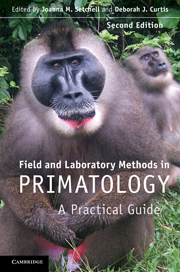Book contents
- Frontmatter
- Contents
- List of contributors
- Foreword by Robert D. Martin
- Introduction
- 1 An ethnoprimatological approach to interactions between human and non-human primates
- 2 Habituating primates: processes, techniques, variables and ethics
- 3 Habitat description and phenology
- 4 Geographical information systems and remote sensing
- 5 Monitoring local weather and climate
- 6 Survey and census methods: population distribution and density
- 7 Trapping primates
- 8 Handling, anaesthesia, health evaluation and biological sampling
- 9 Morphology, morphometrics and taxonomy
- 10 Marking and radio-tracking primates
- 11 Field experiments with non-human primates: a tutorial
- 12 Feeding ecology, frugivory and seed dispersal
- 13 Dietary analysis I: food physics
- 14 Dietary analysis II: food chemistry
- 15 Collecting arthropods and arthropod remains for primate studies
- 16 Recording primate vocalizations
- 17 Photography and video for field researchers
- 18 Chronobiological aspects of primate research
- 19 Thermoregulation and energetics
- 20 Field endocrinology: monitoring hormonal changes in free-ranging primates
- 21 Collection, storage and analysis of non-invasive genetic material in primate biology
- 22 Tips from the bush: an A–Z of suggestions for successful fieldwork
- Index
- References
11 - Field experiments with non-human primates: a tutorial
Published online by Cambridge University Press: 05 June 2012
- Frontmatter
- Contents
- List of contributors
- Foreword by Robert D. Martin
- Introduction
- 1 An ethnoprimatological approach to interactions between human and non-human primates
- 2 Habituating primates: processes, techniques, variables and ethics
- 3 Habitat description and phenology
- 4 Geographical information systems and remote sensing
- 5 Monitoring local weather and climate
- 6 Survey and census methods: population distribution and density
- 7 Trapping primates
- 8 Handling, anaesthesia, health evaluation and biological sampling
- 9 Morphology, morphometrics and taxonomy
- 10 Marking and radio-tracking primates
- 11 Field experiments with non-human primates: a tutorial
- 12 Feeding ecology, frugivory and seed dispersal
- 13 Dietary analysis I: food physics
- 14 Dietary analysis II: food chemistry
- 15 Collecting arthropods and arthropod remains for primate studies
- 16 Recording primate vocalizations
- 17 Photography and video for field researchers
- 18 Chronobiological aspects of primate research
- 19 Thermoregulation and energetics
- 20 Field endocrinology: monitoring hormonal changes in free-ranging primates
- 21 Collection, storage and analysis of non-invasive genetic material in primate biology
- 22 Tips from the bush: an A–Z of suggestions for successful fieldwork
- Index
- References
Summary
INTRODUCTION
Field experiments are a powerful way of investigating the mechanisms of primate behaviour, their adaptive functions, and the cognitive forces responsible for them. They have several major advantages over observational data. First, they can reduce ambiguity about the causal relationship between stimuli and behavioural responses; second, they allow systematic investigations of even rare events; and third, they can test hypotheses more directly by systematically controlling for confounding variables. Although observational data can sometimes achieve the same results, they typically require more complicated statistical procedures and more observation effort. Field experiments can contribute to a range of scientific disciplines, but they have been used most extensively by psychologists interested in the primate mind, behavioural ecologists working on anti-predator behaviour, and anthropologists dealing with proto-human behaviour and primate culture.
In this chapter, we begin with a brief overview of the main observational methods used in primate fieldwork. We then discuss a number of commonly used experimental designs and stimuli, as well as some further techniques with considerable potential for work with wild primates and conclude by drawing attention to common problems and pitfalls.
OBSERVATIONAL METHODS
Field experiments require a profound understanding of the causes and consequences of the behaviours under study, and they should always be the final step in a research programme based on lengthy, detailed and careful behavioural observations. Without such knowledge, there is a considerable danger of data misinterpretation, inadequate experimental design and meaningless findings.
- Type
- Chapter
- Information
- Field and Laboratory Methods in PrimatologyA Practical Guide, pp. 207 - 224Publisher: Cambridge University PressPrint publication year: 2011
References
- 22
- Cited by



